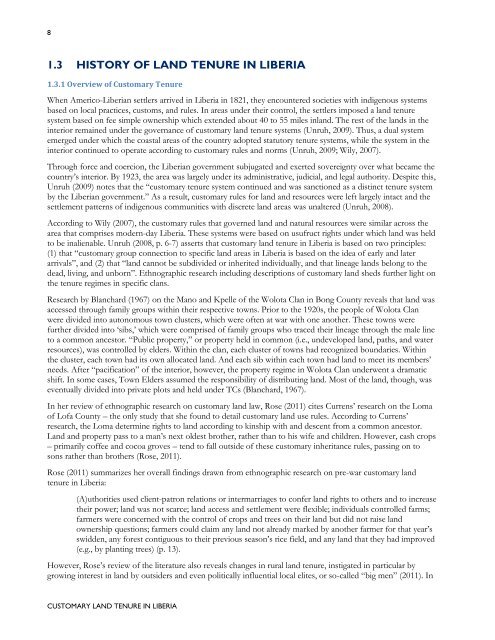Customary Land Tenure in Liberia - Land Tenure and Property ...
Customary Land Tenure in Liberia - Land Tenure and Property ...
Customary Land Tenure in Liberia - Land Tenure and Property ...
You also want an ePaper? Increase the reach of your titles
YUMPU automatically turns print PDFs into web optimized ePapers that Google loves.
8<br />
1.3 HISTORY OF LAND TENURE IN LIBERIA<br />
1.3.1 Overview of <strong>Customary</strong> <strong>Tenure</strong><br />
When Americo-<strong>Liberia</strong>n settlers arrived <strong>in</strong> <strong>Liberia</strong> <strong>in</strong> 1821, they encountered societies with <strong>in</strong>digenous systems<br />
based on local practices, customs, <strong>and</strong> rules. In areas under their control, the settlers imposed a l<strong>and</strong> tenure<br />
system based on fee simple ownership which extended about 40 to 55 miles <strong>in</strong>l<strong>and</strong>. The rest of the l<strong>and</strong>s <strong>in</strong> the<br />
<strong>in</strong>terior rema<strong>in</strong>ed under the governance of customary l<strong>and</strong> tenure systems (Unruh, 2009). Thus, a dual system<br />
emerged under which the coastal areas of the country adopted statutory tenure systems, while the system <strong>in</strong> the<br />
<strong>in</strong>terior cont<strong>in</strong>ued to operate accord<strong>in</strong>g to customary rules <strong>and</strong> norms (Unruh, 2009; Wily, 2007).<br />
Through force <strong>and</strong> coercion, the <strong>Liberia</strong>n government subjugated <strong>and</strong> exerted sovereignty over what became the<br />
country‟s <strong>in</strong>terior. By 1923, the area was largely under its adm<strong>in</strong>istrative, judicial, <strong>and</strong> legal authority. Despite this,<br />
Unruh (2009) notes that the “customary tenure system cont<strong>in</strong>ued <strong>and</strong> was sanctioned as a dist<strong>in</strong>ct tenure system<br />
by the <strong>Liberia</strong>n government.” As a result, customary rules for l<strong>and</strong> <strong>and</strong> resources were left largely <strong>in</strong>tact <strong>and</strong> the<br />
settlement patterns of <strong>in</strong>digenous communities with discrete l<strong>and</strong> areas was unaltered (Unruh, 2008).<br />
Accord<strong>in</strong>g to Wily (2007), the customary rules that governed l<strong>and</strong> <strong>and</strong> natural resources were similar across the<br />
area that comprises modern-day <strong>Liberia</strong>. These systems were based on usufruct rights under which l<strong>and</strong> was held<br />
to be <strong>in</strong>alienable. Unruh (2008, p. 6-7) asserts that customary l<strong>and</strong> tenure <strong>in</strong> <strong>Liberia</strong> is based on two pr<strong>in</strong>ciples:<br />
(1) that “customary group connection to specific l<strong>and</strong> areas <strong>in</strong> <strong>Liberia</strong> is based on the idea of early <strong>and</strong> later<br />
arrivals”, <strong>and</strong> (2) that “l<strong>and</strong> cannot be subdivided or <strong>in</strong>herited <strong>in</strong>dividually, <strong>and</strong> that l<strong>in</strong>eage l<strong>and</strong>s belong to the<br />
dead, liv<strong>in</strong>g, <strong>and</strong> unborn”. Ethnographic research <strong>in</strong>clud<strong>in</strong>g descriptions of customary l<strong>and</strong> sheds further light on<br />
the tenure regimes <strong>in</strong> specific clans.<br />
Research by Blanchard (1967) on the Mano <strong>and</strong> Kpelle of the Wolota Clan <strong>in</strong> Bong County reveals that l<strong>and</strong> was<br />
accessed through family groups with<strong>in</strong> their respective towns. Prior to the 1920s, the people of Wolota Clan<br />
were divided <strong>in</strong>to autonomous town clusters, which were often at war with one another. These towns were<br />
further divided <strong>in</strong>to „sibs,‟ which were comprised of family groups who traced their l<strong>in</strong>eage through the male l<strong>in</strong>e<br />
to a common ancestor. “Public property,” or property held <strong>in</strong> common (i.e., undeveloped l<strong>and</strong>, paths, <strong>and</strong> water<br />
resources), was controlled by elders. With<strong>in</strong> the clan, each cluster of towns had recognized boundaries. With<strong>in</strong><br />
the cluster, each town had its own allocated l<strong>and</strong>. And each sib with<strong>in</strong> each town had l<strong>and</strong> to meet its members‟<br />
needs. After “pacification” of the <strong>in</strong>terior, however, the property regime <strong>in</strong> Wolota Clan underwent a dramatic<br />
shift. In some cases, Town Elders assumed the responsibility of distribut<strong>in</strong>g l<strong>and</strong>. Most of the l<strong>and</strong>, though, was<br />
eventually divided <strong>in</strong>to private plots <strong>and</strong> held under TCs (Blanchard, 1967).<br />
In her review of ethnographic research on customary l<strong>and</strong> law, Rose (2011) cites Currens‟ research on the Loma<br />
of Lofa County – the only study that she found to detail customary l<strong>and</strong> use rules. Accord<strong>in</strong>g to Currens‟<br />
research, the Loma determ<strong>in</strong>e rights to l<strong>and</strong> accord<strong>in</strong>g to k<strong>in</strong>ship with <strong>and</strong> descent from a common ancestor.<br />
<strong>L<strong>and</strong></strong> <strong>and</strong> property pass to a man‟s next oldest brother, rather than to his wife <strong>and</strong> children. However, cash crops<br />
– primarily coffee <strong>and</strong> cocoa groves – tend to fall outside of these customary <strong>in</strong>heritance rules, pass<strong>in</strong>g on to<br />
sons rather than brothers (Rose, 2011).<br />
Rose (2011) summarizes her overall f<strong>in</strong>d<strong>in</strong>gs drawn from ethnographic research on pre-war customary l<strong>and</strong><br />
tenure <strong>in</strong> <strong>Liberia</strong>:<br />
(A)uthorities used client-patron relations or <strong>in</strong>termarriages to confer l<strong>and</strong> rights to others <strong>and</strong> to <strong>in</strong>crease<br />
their power; l<strong>and</strong> was not scarce; l<strong>and</strong> access <strong>and</strong> settlement were flexible; <strong>in</strong>dividuals controlled farms;<br />
farmers were concerned with the control of crops <strong>and</strong> trees on their l<strong>and</strong> but did not raise l<strong>and</strong><br />
ownership questions; farmers could claim any l<strong>and</strong> not already marked by another farmer for that year‟s<br />
swidden, any forest contiguous to their previous season‟s rice field, <strong>and</strong> any l<strong>and</strong> that they had improved<br />
(e.g., by plant<strong>in</strong>g trees) (p. 13).<br />
However, Rose‟s review of the literature also reveals changes <strong>in</strong> rural l<strong>and</strong> tenure, <strong>in</strong>stigated <strong>in</strong> particular by<br />
grow<strong>in</strong>g <strong>in</strong>terest <strong>in</strong> l<strong>and</strong> by outsiders <strong>and</strong> even politically <strong>in</strong>fluential local elites, or so-called “big men” (2011). In<br />
CUSTOMARY LAND TENURE IN LIBERIA

















